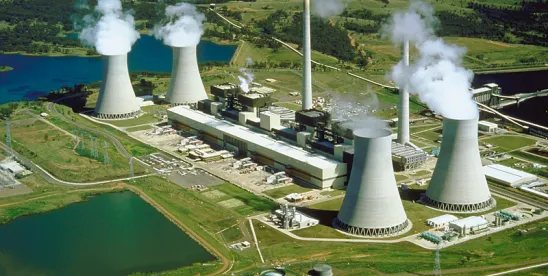The NRC Staff recently published proposed guidance documents for Second License Renewal—a significant milestone in the path toward extending the licensed life of nuclear plants from 60 years to 80 years—but some of the changes warrant additional focus from the industry.
In December 2015, the Nuclear Regulatory Commission (NRC) Staff issued two important guidance documents for public comment: NUREG-2191, the “Generic Aging Lessons Learned for Subsequent License Renewal” (GALL-SLR) and NUREG-2192, the “Standard Review Plan for Review of Subsequent License Renewal Applications for Nuclear Power Plants” (SRP-SLR).[1] This is a significant milestone in the Staff’s preparations for receiving and reviewing Second License Renewal (SLR) applications, which, if granted, would authorize operation of commercial nuclear power plants beyond 60 years. The Staff is seeking public comment on both documents and expects to issue final versions in July 2017.
Background
The Atomic Energy Act and NRC regulations do not set a limit on the number of times that a reactor operating license can be renewed for an additional 20 years. Most reactors have obtained a first renewed operating license, and several have begun operating beyond the initial licensed term of 40 years. In recent years, industry, the NRC, and other entities have been developing the technical basis and regulatory framework for SLR applications. On the regulatory side, in September 2014, the Commission rejected an NRC Staff proposal to undertake a rulemaking for SLR and instead directed the Staff to update its existing guidance documents, as needed, to provide additional clarity on the SLR regulatory framework. The Staff’s new draft guidance documents are an important step to implement that directive.
The New Guidance
The proposed GALL-SLR will retain most of the aging management programs (AMPs) that licensees have or will have in place following first license renewal, whether in existing form or with some modifications. Likewise, the guidance in the SRP-SLR remains largely consistent with the guidance for first license renewals, including the sufficiency checklist to determine the acceptability of an application for docketing and the guidance on scoping and screening methodology.
The new draft guidance documents continue the NRC’s focus on certain key technical issues for SLR, specifically reactor pressure vessel neutron embrittlement at high fluence, irradiation-assisted stress corrosion cracking (IASCC) of reactor internals and primary system components, concrete and containment degradation, and electrical cable qualification and condition assessment. The NRC and industry are already focused on these particular topics, and the available information suggests that none of these technical issues would, as a generic matter, prevent plants from operating safely for 80 years.
There are, however, extensive proposed modifications to aging management review guidelines and individual AMPs that warrant a thorough technical review. One significant change for SLR affects the AMP for pressurized water reactor (PWR) vessel internals.[2] For first license renewal, the NRC Staff endorsed the Electric Power Research Institute’s (EPRI’s) Materials Reliability Program (MRP) guidelines in “MRP-227-A” as the basis for an acceptable AMP for these components.[3] As explained in the draft SRP-SLR, however, the MRP-227-A guidelines are based on an assessment of aging effects only through 60 years of operation. The EPRI MRP has yet to assess whether operations beyond 60 years will require changes to the inspection guidelines in MRP-227-A. In the absence of such an assessment, the Staff’s draft guidance requires applicants to develop a plant-specific AMP. SLR applicants therefore will need to develop plant-specific programs to manage the effects of aging on PWR vessel internals through 80 years of operation and to justify their programs to the NRC.
PWR internals have been the subject of significant NRC attention and intervenor concerns in first license renewals, including substantial consideration of the potential combined effects of multiple aging mechanisms. After considerable effort by the industry and the NRC Staff’s lengthy technical review, the Staff found the MRP-227-A guidelines acceptable for first license renewals and defended that position in recent litigation before the Atomic Safety and Licensing Board. Further technical research on ongoing aging effects, however, will be necessary to demonstrate acceptability for an additional 20 years of operation. Based on experience with first license renewal applications, SLR applicants should anticipate a thorough NRC review of their reactor vessel internals AMPs and plan accordingly.
Some of the other significant modifications to NRC Staff guidance include the following:
-
A new AMP called “Cycle Load Monitoring” to address all cyclic fatigue time-limited aging analyses (TLAAs), including cumulative usage factor calculations, environmentally assisted fatigue evaluations, other cycle counting evaluations, fatigue flaw growth analyses, and similar analyses
-
A new AMP called “Neutron Fluence Monitoring” for use in conjunction with the Reactor Vessel Surveillance AMP. This new AMP provides a basis for managing neutron fluence–based TLAAs for reactor pressure vessels and reactor vessel internal components, including pressurized thermal shock, Charpy upper-shelf energy, and pressure-temperature limit analyses
-
Three new, separate AMPs that address electrical insulation for inaccessible cables and cover medium-voltage, instrument and control, and low-voltage cables
-
A new AMP for high-voltage insulators
The new proposed guidance relates to the safety review of SLR applications. On the environmental side, the NRC updated its Generic Environmental Impact Statement (GEIS) for license renewal in 2013 and later concluded that the GEIS update is adequate for SLR purposes, so there are no additional plans to modify the environmental review process for SLR.
The Staff is holding public meetings on its draft guidance on January 21, January 22, and February 23 in Rockville, Maryland, and will take public comments through February 29, 2016. A briefing by the NRC Staff for the Advisory Committee on Reactor Safeguards is scheduled for February 17. Morgan Lewis plans to attend these meetings and will continue to monitor regulatory developments on SLR, including progress on addressing the NRC’s key technical issues. In addition, industry working groups are developing technical comments on the Staff’s proposed guidance.
[1] NUREG-2191, Generic Aging Lessons Learned for Subsequent License Renewal report (Dec. 2015), Volume 1 and Volume 2; NUREG-2192, Standard Review Plan for Review of Subsequent License Renewal Applications for Nuclear Power Plants, Draft Report for Comment (Dec. 2015).
[2] The boiling water reactor vessel internals program contains some updates, but the generic, NRC-approved AMP remains in place.
[3] EPRI, MRP-227-A, Materials Reliability Program: Pressurized Water Reactor Internals Inspection and Evaluation Guidelines (Dec. 2011) (ML12017A191 through ML12017A197 and ML12017A199).





 />i
/>i

